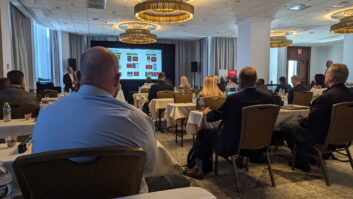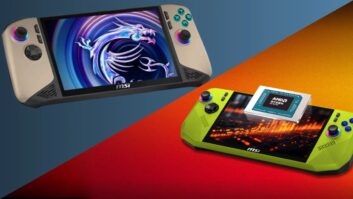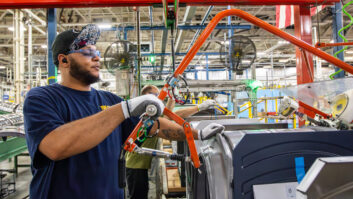SEATTLE –
This month marks the 12th anniversary
of
’s CE business.
During that time, Jeff Bezos’ brainchild has grown
from an online bookseller to a full-line virtual behemoth.
Living up to its namesake river, the
company’s vast assortment now winds
its way through nearly every consumer
product category. But it is CE, along
with books, that has become one of
Amazon’s largest business segments,
bringing in an estimated $7.9 billion last year in the
U.S. alone.
It wasn’t easy. Amazon, like most early pure-play
e-tailers, was initially shunned by manufacturers who
feared the new distribution channel, forcing Amazon’s
first CE chief Christopher Payne to develop a
patchwork of two-step and, some suppliers surmised,
transshipped distribution.
But thanks to the efforts of veteran CE successors
Frank Sadowski (Silo, Sun TV) and Noah Herschman
(Tweeter), Amazon’s array of authorized suppliers
grew, along with its customer base and sales.
Today, Amazon’s CE VP Paul Ryder rides herd over
an expansive electronics assortment spanning all
categories and price points, while digital innovations
such as Kindle, the company’s best-selling product;
Instant Video, its content-delivery platform; and its
new Appstore and Cloud Drive storage service, drive
additional traffic and revenue.
Ryder, a former GE Appliance and
Honeywell Aerospace exec who marks
his fifth anniversary at Amazon next
month, recently spoke with TWICE
about electronics, e-commerce and the
nation’s No. 4 CE retailer.
TWICE:
How’s business?
Ryder:
Still very positive and showing strong
growth, although there are supply issues related to
the tragedy in Japan.
TWICE:
What kind of constraints are you experiencing?
Ryder:
It’s deep in the supply chain and limited
mostly d-SLRs, although we’ve also seen some delays
with LCD panels. It’s a temporary issue, as Japanese
production is restarting rather dramatically. The
key issue now is energy supply, to ramp up LCD production.
Based on my conversations with vendors in
Japan, the constraints will continue through the summer
but Q3 will be much better.
TWICE:
Summer is traditionally a sluggish time for
CE, but many retailers are reporting a fall-off in business
that goes beyond seasonal doldrums.
Ryder:
We’re still seeing strong growth across
all categories, although we’re also seeing a shift
to smaller stuff. Portable electronics like GPS, mobile,
personal audio and Kindle are getting much
more activity.
TWICE:
Let’s talk about some specific categories.
TV …
Ryder:
Every category has some new, cool feature
driving activity. In TV, we were very successful this
past holiday season through now with 3D and smart
models. There was also a lot of excitement around
opening-price-point products. But we sell a true mix of models. If you look at it by screen
size, the units we sell that are 46 inches
and above tend to be advanced
TVs, and eight out of 10 of our 55-inch
and over best-sellers are connected or
3DTVs.
Those advanced capabilities are
much deeper in the new 2011 lines,
and are treated as features
rather than an end
unto themselves.
TWICE:
What about
tablets?
Ryder:
We’ve had a
dedicated tablet store for
the last six to eight months. It’s been
very active since day one and continues
to gain momentum as more Android
models get released. We mostly
offer Android tablets although a whole
host of platforms and models are available,
including Windows-based tablets
and iPads through affiliate retailers.
We have multiple stakes in this category,
as we are also involved with
apps. We asked ourselves ‘How do
we participate in this new ecosystem?’
and so we launched our Appstore.
It now has over 10,000 apps and we
introduce new ones every day. We’re
working closely with all vendors not
only on how we can market tablets and
distribute them, but also provide great
content for them.
We also benefit from Kindle. Millions
of customers are interested in e-reading,
and when they come to learn about
Kindle, some want more features, they
want a multipurpose device, so that
also leads to tablet sales.
TWICE:
Speaking of Kindle, Amazon
is rumored to also be developing
a proprietary tablet. True?
Ryder:
I’ll only quote my boss Jeff
Bezos, whose comment
on the subject was “Stay
tuned.”
TWICE:
You also run a
wireless store.
Ryder:
Yes, we’re a
direct dealer for the four
main carriers. We built a special-purpose
website with a dedicated team
that’s directly connected into their
systems. Being an authorized reseller
requires deep integration with the carriers
for things like credit checks. It’s a
daunting transaction, but we’ve worked
hard to keep it clean and simple.
TWICE:
How has that business
been performing?
Ryder:
We’re seeing very strong
growth. Everyone has a smartphone
now, so for us it’s about upgrades and
service. The bulk of our business is in
Android smartphones and the customers
are very interested in the products.
It represents a big purchase decision
and a big commitment, so they do a ton
of research online. We expect that category
will continue
to do well.
TWICE:
Have
your hardware sales
benefitted from the
software support of
an Appstore, VOD
platform and cloud
service?
Ryder:
I don’t
know if there’s a
synergistic effect on
hardware; we don’t
look at it that way.
With Amazon Instant
Video, we’re a
big media and software
provider and
wanted to be there
as we move from
physical to digital
media. We can
now stream content
through a wide
range of devices,
and we offer over
6,000 free movies
and TV shows to our
Amazon Prime members.
It’s been great.
With the Cloud
Drive, everyone
can now have their
music in one place
and stream it from
everywhere, rather than have their collections locked into
separate devices. It supports our MP3
store, where we can do [99-cent album
download] Lady Gaga promotions.
TWICE:
Do you own your own inventory?
Ryder:
The vast majority of stuff
that Amazon sells is our own inventory.
It’s about supporting the growth of the
business, vs. drop-shipping. We position
it as close to our customers as
possible, to provide two-day shipping
through Amazon Prime and a next-day
upgrade for $3.99. Think about it —
we have millions of SKUs and can get
them to you tomorrow for $3.99.
We’re not thought of as a brick-andmortar
retailer, but we do have lots of
brick-and-mortar thanks to our warehouses.
TWICE:
Do you foresee a diminished
role for brick-and-mortar retail as
e-commerce continues to grow?
Ryder:
Many people have an old
view of either-or. It’s both. The web has
become a core part of our lives and
shopping habits, but it is very complimentary
to physical shopping. The Internet
is a starting point for education,
product comparisons and customer
reviews, and manufacturers need to
appreciate that it’s the first place consumers
need to go.
Remember, we also have our own
CE product [Kindle] that’s distributed
through many stores, so we see it as a
complimentary relationship.
TWICE:
But many manufacturers,
and certainly physical retailers, still
see e-commerce as disruptive, particularly
when it comes to MAP policy.
Ryder:
First of all, it’s a misperception
that the Internet has a lower cost
structure. It’s just not true. Free shipping,
brick-and-mortar warehouses and
thousands of engineers represent significant
overhead. We don’t have end
caps, but we have our own costs.
Retailers are free to set our own prices,
and we’ve had many discussions
with vendors about it. We try to make
our shopping experience simple, with
no distractions. We want to provide
a great shopping experience, as opposed
to someone coming to a website
and being unable to see the price of a
product unless they click on something
else. The customer thinks it’s a trick,
and gets frustrated or confused, and
our conversion rate with MAP treatment
is lower. That’s not good for the
customer or the vendor.
The Internet has been hyper-competitive
from day one. We want to be
competitive with market prices every
day in order to deliver value and build
long-term customer trust.
TWICE:
What’s your outlook for the
holiday selling season?
Ryder:
The supply issues will improve,
based on discussions with vendors,
and we expect that customer interest
and demand will continue to be
strong through the balance of the year.













